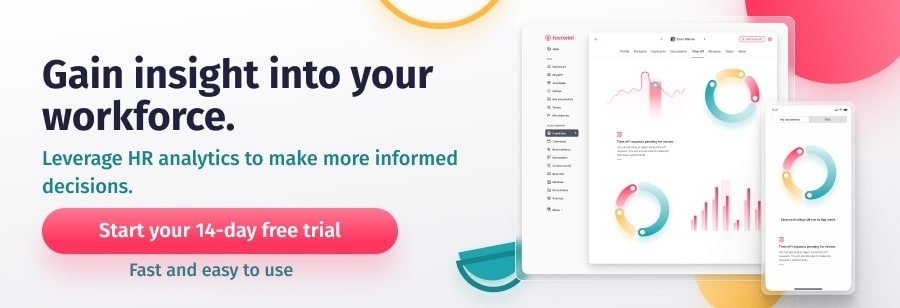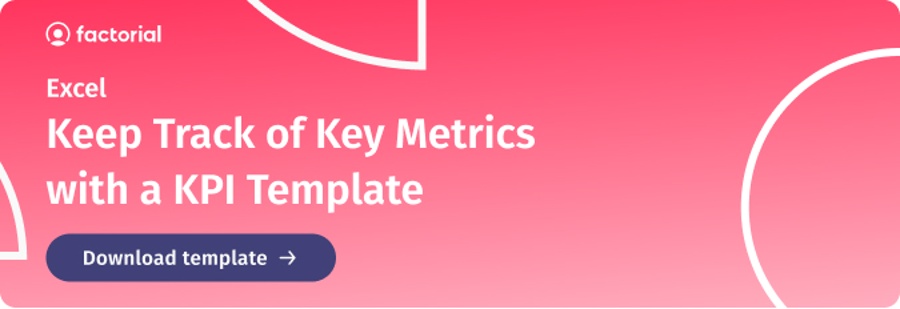HR managers often walk the line between data analysts and people managers. To do this with flair, they need an intuitive presentation of employee data. This is where HR dashboards come into play. An HR Dashboard gives HR professionals the ability to place a name and face to numbers and place people at the core of their decisions.
In addition to making information easier to understand, HR dashboards make generating data reports a breeze. Automated dashboards and HR reports are the most efficient ways of synthesizing and communicating the large volume of information that HR professionals handle. But, what are the different kinds of HR dashboards? And how can they improve your team’s direction?
This article is a comprehensive guide to the types and uses of dashboards in human resources.
- What is an HR Dashboard?
- Benefits of an HR Dashboard
- HR Analytics: Which to Include
- Employee Dashboard vs. HR Dashboard
- Types of HR Dashboards
What is an HR Dashboard?
An HR dashboard is a tool used to centralize and manage HR reports and HR Key Performance Indicators (KPIs). Like pilots or drivers, human resources similarly use a dashboard as a control panel. They can use it to steer their workforce to new territories, safely and smoothly.
HR dashboards can be especially useful strategic devices. Depending on goals and intended objectives, professionals can create HR reports and determine which KPIs to keep track of. From demographics to payroll, this instrument can be used for all of human resources responsibilities.
Benefits of an HR Dashboard
Perhaps the most obvious advantage for HR professionals is the ability to manage data within one central location. Aside from this asset, some of the benefits include:
- Increased flexibility- With the move to online work, hr departments and employees are looking for ways to keep tabs on data from afar. An employee dashboard means instant HR to employee communication and access to needed information.
- Recognition of trends- Having graphical representations of HR KPIs will allow you to better understand the patterns and cycles of your business. This information can help to detect issues before they become serious problems.
- Improved productivity- Employee dashboards can act as a platform through which everyone can share daily achievements and excitement. Visible progress can encourage employees to encourage each other. With an employee dashboard, every advancement becomes a team success story.
- Effective campaigns- HR professionals can use analytics tools to evaluate the outcomes of their initiatives. This information can help to drive potent future campaigns. If change is needed, HR dashboards can help to make it happen.
- Reduced expenses- In short, analytics dashboards can help HR to make smarter and faster decisions. Reduced training costs, hiring expenses, and turnover rate are just some of the ways that HR can leverage analytics to save money.
HR Analytics: What Data Should I Include?
Generally, the creation of HR reports and selection of performance indicators should cohere with the business strategy you want to adopt. Having important HR metrics laid out can help you to notice and seize growth opportunities. Above all, it’s about knowing how to use data to your advantage. Learn how to use KPIs in Human Resources.
Measuring metrics can also help HR with problem-solving diagnostics. In markets where employee turnover rates are high, HR must catch and respond to management problems. Dashboards enable HR a tangible and reliable means of doing so.
Before deciding upon which metrics to include, HR professionals should ask themselves:
- What are the company’s goals?
- Which metrics need to improve?
- Where is there inefficiency in HR reporting?
- Who will use this dashboard? Recruiters? HR Managers?
Generally speaking, when determining which information that you need, it is best not to spread yourself too thin. Less is more when it comes to key performance indicators for your dashboard.
Look for KPIs that can guarantee improvement of the company’s HR structure, rather than filling your screen with unnecessary figures. Customizable and user-friendly interfaces will save you time and headaches.
What is the Difference Between an Employee Dashboard and an HR Dashboard?
The difference between HR dashboards and employee dashboards is simple. HR dashboards are used by HR professionals and contain automated HR reports generated from KPIs and Analytics. Employee dashboards, on the other hand, are used by all members of the workforce. With these dashboards, employees can manage their hours and absences, among other daily activities.
HR Dashboards
Human resources dashboards are all-inclusive tools that display the evolution of the workforce. There are different categories and types of dashboards that HR professionals can use. Software like Factorial HR allows you to create custom dashboards and HR reports for your company’s needs.
Employee Dashboards
The features included in these dashboards allow employees to clock in and out, ask for time off, and keep track of coworkers’ days off. Interactive dashboards allow HR managers to communicate tasks with individual employees and with the entire team.

Types of HR Dashboards
What are some of the possible dashboards that HR professionals can create? Here are some of the most common HR dashboards that help professionals get the most out of analytics.
Hiring Dashboard
With a hiring dashboard, you can create hr reports based on workforce analytics and KPIs. This will help you to identify workplace gaps, measure the hiring expenses, and pinpoint features of successful candidates. Ideally, these indicators will help to create more effective and smoother recruitment processes. To further facilitate the hiring process, try an applicant tracking system.
Suggested HR reports to include: Headcount, hired employees per month, employees by contract type, hiring expenses, training expenses
Diversity Dashboard
With a diversity dashboard, you can detect pay gaps, promotion gaps, and raise gaps. Also, HR managers can visualize and manage workforce demographics. Aside from keeping tabs on the demographic makeup of your workforce, a diversity dashboard allows you to improve workplace inclusivity efforts and pay equality. While creating diversity, equity, and inclusion programs, it is important to stay updated and make changes when need be!
Suggested HR reports to include: Headcount, employees by team, employees by gender, employees by nationality, seniority average of employees, age average of employees
Leave Management Dashboard
Not only can time off indicate the number of absences, it can also serve as a tool to monitor the mental and physical health of your workforce. Based on the HR reports created for this dashboard, you will be able to identify the type of absence, the causes, and the frequency of occurrence. In addition, HR professionals can visualize paid and unpaid time off, calculate costs, and change the parameters to fit company policy.
Suggested HR reports to include: Employee absences per month, Absences by type, average duration of sick leave, list of pending absences
Performance Dashboard
An employee performance dashboard can help you to use people analytics to your advantage. Generally, performance dashboards measure the goals, reviews, and accomplishments of your workforce. With a performance dashboard, the achievements of outstanding talent are on display, making appraisals and evaluations easy.
Suggested HR reports to include: Employee appraisals, employee satisfaction ratings, employee goal completion

Training Dashboard
Training dashboards help to manage workforce development. For HR professionals, training dashboards can help to recognize skill gaps and take note of employees with exceptional abilities. With a training dashboard, you can identify employee skillsets, deficits, and desired career growth.
Suggested HR reports to include: Training progress, training hours, training expenses
Retention Dashboard
Does your company have a high turnover rate? Turnover and attrition rates are some of the most crucial KPIs for company health. Like absenteeism, high turnover and attrition rates similarly indicate problems in the workplace. HR professionals can use these indicators to make informed decisions about how to improve employee engagement and create a healthier work environment.
Suggested HR reports to include: Headcount, monthly headcount by team, monthly hires, and terminations


